#143: Boletinellus merulioides, the Ash Tree Bolete
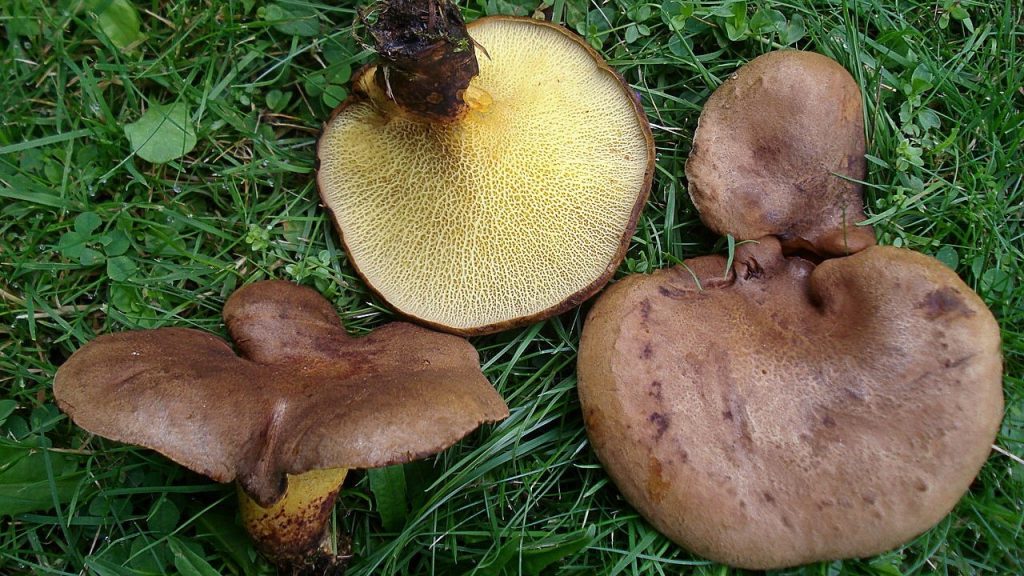
The Ash Tree Bolete (Boletinellus merulioides) is an unusual bolete, both morphologically and ecologically. It has a very thin pore surface, a brown cap, and grows exclusively under ash trees. Photo by Dave W [CC BY-SA 3.0], via Wikimedia Commons
Description
The Ash Tree Bolete is a medium to large bolete with an irregular shape, off-center to lateral stipe, and very thin tube surface. The cap is roughly circular, but is often lobed and wavy or even somewhat kidney-shaped when the stipe is close to the edge of the cap. It is mostly convex when newly-formed but becomes flat or even vase-shaped as it ages. On the top, the Ash Tree Bolete is smooth and leathery and is colored brown with shades of yellow or red.1,2
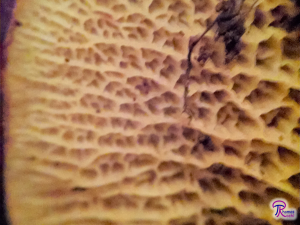
B. merulioides has a very thin tube surface that is arranged like gills. In fact, some of the larger ridges often appear gill-like.
The mushroom’s tube surface is yellowish to brownish green. The tubes are unusually shallow for boletes and may look more like reticulation or a network of ridges than fully-formed tubes. They run down the stipe and are roughly arranged like gills, with the longest axis of the tube pointing toward the stipe. In some specimens, the tubes may actually look more like gills with many cross-veins. Spores are produced on the tube surface and are olive-brown when deposited in a spore print.1,2
Unlike nearly every other bolete, the Ash Tree Bolete has a stipe that is rarely in the center of the cap. More often than not, the stipe is off-center (eccentric) and is sometimes found at the edge of the pileus (lateral). The stipe is only 2-4cm tall while the cap grows 3-20cm, making the mushroom rather short and stocky. Below the end of the tube surface, the stipe is dark brown or the same color as the cap. All surfaces bruise brownish or sometimes bluish. The mushroom’s flesh is soft, is colored whitish or yellowish, and may or may not bruise brown or blue.1,2
Ecology
Perhaps the most interesting feature of this mushroom is its relationship with the Leafcurl Ash Aphid (Prociphilus fraxinifolii, also listed as Meliarhizophagus fraxinifolii). Most boletes get their energy from trees through mutualistic mycorrhizal relationships. B. merulioides, however, uses a completely different strategy: it gets its energy from Leafcurl Ash Aphids. The aphids feed on leaves of ash trees, where they cause the leaves to curl. More importantly for B. merulioides, the aphids also feed on roots of ash trees. The fungus actually protects the underground aphids by encasing them in a small, dark-colored knot of mycelium called a “sclerotium.” The sclerotia are roughly spherical and only 2 to 3mm in diameter. These structures are hollow and help protect the aphids from predators. Since the aphids feed on ash roots, the sclerotia usually partially enclose the root. In return for protection, the fungus feeds off of the honeydew (essentially sugar-rich aphid poop) secreted by the aphids. This is a mutualistic relationship for the Ash Tree Bolete and the Leafcurl Ash Aphid, but those two have a parasitic relationship with ash trees.1,3
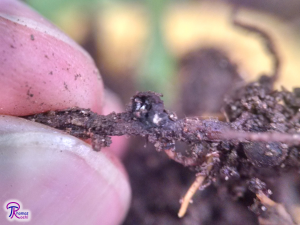
The Ash Tree Bolete produces sclerotia on the roots of ash trees. These sclerotia contain barely visible aphids which provide the fungus with food. In the photo, the sclerotium is the black circle with white dots in it.
Since the aphids feed only on ash trees, B. merulioides appears exclusively under ash trees (Fraxinus spp.). The aphids and mushrooms are most commonly found under Green Ash (Fraxinus pennsylvanica), but can grow under any species of ash within their respective ranges. B. merulioides is common in eastern and northern North America and may also inhabit southwestern North America. The mushrooms are common sights under ash trees in the summer and fall, usually producing numerous mushrooms spread over a wide area.1,2
Unfortunately, these mushrooms could become rare in the near future. With the Emerald Ash Borer (Agrilus planipennis) killing trees in most of eastern North America, ash trees may go the way of the elms and chestnuts. If the ash trees die, then so will the Leafcurl Ash Aphids, leaving no food source for B. merulioides. Remember not to transport firewood and try to see one of these mushrooms before they are all gone.
Edibility and Use
B. merulioides gets mixed reviews when it comes to edibility. Some websites list it as edible while others say inedible. Within the edible group, the consensus seems to be that the mushroom is not particularly good (although it might be better when very young).2,4,5 In eastern North America, the general rule for boletes is: don’t eat it if it has red pores, stains blue, or is too bitter. The Ash Tree Bolete does stain blue (at least sometimes), so it fails this test. If you are not confident in your identification, stick to that rule; you won’t be missing much if you don’t eat B. merulioides.
However, the Ash Tree Bolete is useful for more than just food; it can also be used to dye wool (see FFF#159). B. merulioides mushrooms will produce brown and orange colors, depending on the mordant used. It is not a very strong dyer, but if you have a lot of these mushrooms and don’t want to eat them you might as well use them for something else!6
Taxonomy
The Ash Tree Bolete has been transferred in and out of a number of different genera over the years. As a result, field guides often list this species as Gyrodon merulioides. The genus Boletinellus is one of the earliest diverging lineages of the boletes, indicating that B. merulioides is likely similar to ancestral boletes.1
| Kingdom | Fungi | Animalia | Plantae |
| Subkingdom | Bilateria | Viridiplantae | |
| Infrakingdom | Protostomia | Streptophyta | |
| Superdivision (Superphylum) | Ecdysozoa | Embryophyta | |
| Division (Phylum) | Basidiomycota | Arthropoda | Tracheophyta |
| Subdivision (Subphylum) | Agaricomycotina | Hexapoda | Spermatophytina |
| Class | Agaricomycetes | Insecta | Magnoliopsida |
| Subclass | Pterygota | ||
| Infraclass | Neoptera | ||
| Superorder | Agaricomycetidae | Paraneoptera | Asteraneae |
| Order | Boletales | Hemiptera | Lamiales |
| Suborder | Sternorrhyncha | ||
| Superfamily | Aphidoidea | ||
| Family | Boletinellaceae | Aphididae | Oleaceae |
| Subfamily | Eriosomatinae | ||
| Tribe | Pemphigini | ||
| Genus | Boletinellus | Prociphilus | Fraxinus L.7 |
| Species | Boletinellus merulioides (Schwein.) Singer8 | Prociphilus fraxinifolii (Riley)9–11 |
Just by looking at that table, you can tell which kingdom gets the most attention. Do animal taxonomists really need all those divisions?
This post does not contain enough information to positively identify any mushroom. When collecting for the table, always use a local field guide to identify your mushrooms down to species. If you need a quality, free field guide to North American mushrooms, I recommend Michael Kuo’s MushroomExpert.com. Remember: when in doubt, throw it out!
See Further:
http://www.mushroomexpert.com/boletinellus_merulioides.html
http://www.rogersmushrooms.com/gallery/DisplayBlock~bid~5597.asp
http://oregonstate.edu/dept/nurspest/woolyashaphid/introduction.htm
Citations
- Kuo, M. Boletinellus merulioides. MushroomExpert.Com (2015). Available at: http://www.mushroomexpert.com/boletinellus_merulioides.html. (Accessed: 28th July 2017)
- Labbé, R. Boletinellus merulioides (Schw.) Murrill Mycologia 1(1): 7, 1909. Champignons du Québec (2017). Available at: http://www.mycoquebec.org. (Accessed: 28th July 2017)
- Brundrett, M. C. & Kendrick, B. The relationship between the ash bolete (Boletinellus merulioides) and an aphid parasitic on ash tree roots. Symbiosis 3, 315–320 (1987).
- Phillips, R. Boletinellus merulioides. Rogers Mushrooms Available at: http://www.rogersmushrooms.com/gallery/DisplayBlock~bid~5597.asp. (Accessed: 27th May 2017)
- Bergo, A. Ash Tree Boletes or Boletinellus Mushrooms. Forager | Chef (2013). Available at: http://foragerchef.com/ash-tree-bolete-mushrooms/. (Accessed: 28th July 2017)
- Bessette, A. & Bessette, A. Mushrooms to Dye For. North American Mycological Association (2015). Available at: http://www.namyco.org/mushrooms_to_dye_for.php. (Accessed: 28th July 2017)
- ITIS Standard Report Page: Fraxinus. Integrated Taxonomic Information System Available at: https://www.itis.gov/servlet/SingleRpt/SingleRpt?search_topic=TSN&search_value=32928#null. (Accessed: 28th July 2017)
- Boletinellus merulioides. Mycobank Available at: http://www.mycobank.org/Biolomics.aspx?Table=Mycobank&Rec=415277&Fields=All. (Accessed: 28th July 2017)
- species Prociphilus (Meliarhizophagus) fraxinifolii (Riley, 1879). Aphid Species File Available at: http://aphid.speciesfile.org/Common/basic/Taxa.aspx?TaxonNameID=1162126. (Accessed: 28th July 2017)
- tribe Pemphigini Herrich-Schaeffer, 1854. Aphid Species File Available at: http://aphid.speciesfile.org/Common/basic/Taxa.aspx?TaxonNameID=1161696. (Accessed: 28th July 2017)
- ITIS Standard Report Page: Aphididae. Integrated Taxonomic Information System Available at: https://www.itis.gov/servlet/SingleRpt/SingleRpt?search_topic=TSN&search_value=109191#null. (Accessed: 28th July 2017)

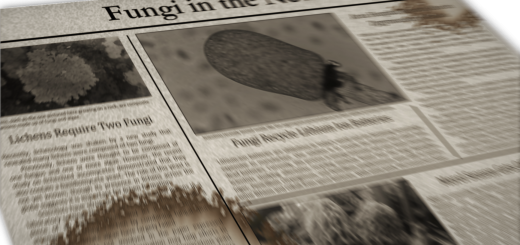
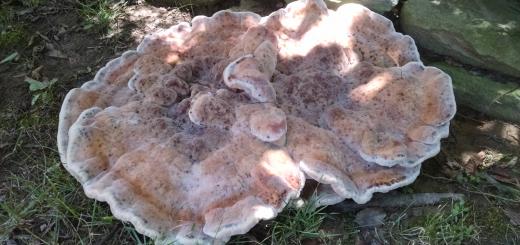






![#011: Characteristics of Kingdom Fungi [Archived]](https://www.fungusfactfriday.com/wp-content/themes/hueman/assets/front/img/thumb-small-empty.png)

1 Response
[…] #143: Boletinellus merulioides, the Ash Tree Bolete […]